What do virtual teams and long-distance relationships have in common?
They are both built on mutual trust, understanding, and commitment to stay in touch despite the geographical distance.
While I find all three aspects essential, I have to prioritize trust in both cases.
Trust takes a long time to establish. Also, once it’s lost, trust takes ages to get back, if at all.
A worrisome statistic comes from the Workforce Institute’s Trust in the Modern Workplace Report — about 38% of employees believe that their organization won’t put their interests before profits.
So, in this blog post, we’ll learn more about building trust in virtual teams, explain why this is important, and list useful tips to help you nurture trust in your team.
Table of Contents
What is trust in virtual teams?
While looking for the proper definition of trust, I came across the one by Charles Feltman, an expert on trust and a leadership coach.
In his Thin Book of Trust, he defined trust as “choosing to make something important to you vulnerable to the actions of someone else.”
In other words, when we decide to trust someone, we do so because we are sure they will support us in what we do, or at least won’t hurt us.
I chose to open with Feltman’s definition because it tackles the moment of vulnerability that seems crucial for building trust between people — particularly between those who are geographically scattered across the globe.
An example of trust in virtual teams
I always like to support my writing with examples. This time around, I want to share something from my experience to help you paint a better picture about trust in remote teams.
Last week, I texted a teammate. We have been working in the same team for six months now, however, remotely. She was in a minor accident the day before, and I wanted to make sure she was doing okay, physically at least.
We texted for a while, and all of a sudden she decided to share a detail from her life, something quite personal.
At first, I was shocked — shocked by the information and shocked by her desire to share this with me. We saw each other just once and we haven’t talked much before, so you can imagine my surprise.
In the morning, I continued researching the topic of trust and had a moment of revelation.
She trusts me!
She willingly chose to be vulnerable with me and felt she could trust me enough to tell me something that really mattered to her.
This right here is what trust in virtual teams looks like.
Consciously opening up to people you work with, relying on them for help, and allowing them to be part of your life, even though you’re miles apart.
When I think again, I’ve got more than one peer trusting me with important things in their lives and I can only think of how courageous they are.
Because trust takes a lot of courage and hope that we have chosen the right person to trust, especially when they aren’t geographically close.
This brings me to the next point I want to discuss — the importance of trust for virtual teams.
18 Behaviors that build trust in virtual teams
While building trust among members of your remote and hybrid teams can be challenging, it’s most definitely worth your effort.
Let’s focus here on what you, as a manager, can do to build and nurture trust in your team, even if they are scattered across several time zones and countries.
Read on, because we have 18 handy tips to help you achieve this.
Tip#1: Have a functional work-from-home policy
If you want to handle your remote or hybrid team successfully and build trust among your people despite the geographical distance, you should invest time in providing them with an operational work-from-home policy.
Why does a work-from-home policy matter?
- It provides employees with structure and direction.
- It helps reduce stress and boost productivity.
- It facilitates effective communication and collaboration.
- It paves the way to stronger workplace relationships.
To make work easier, your work-from-home policy should include information related to the working hours, accepted behavior, the use of collaboration tools, etc.
Creating a unique policy that works for everyone might be hard. To help you get on your feet, we’ve prepared this free Work From Home Policy Template you can use at any point.
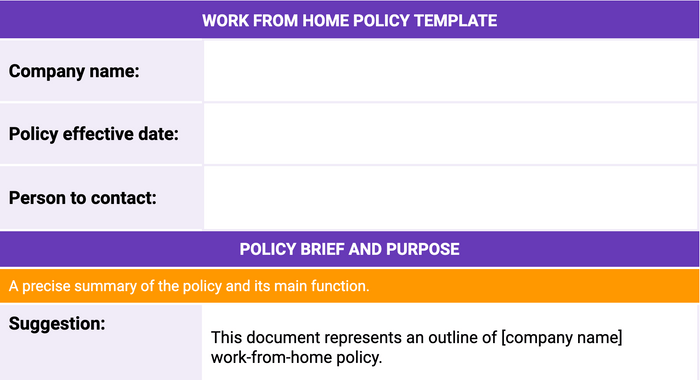
Tip #2: Know the “anatomy of trust”
In the 2015 speech in which she explains the “anatomy of trust”, Brené Brown, a professor, and social scientist talked about the anatomy of trust.
She created an acronym, BRAVING, to account for all the parts of trust.
So what parts of trust did Brown identify?
- BOUNDARIES: Setting boundaries means clearly stating what’s okay and what’s not okay, and explaining why.
- RELIABILITY: We do what we say we are going to do. At work, this refers to being aware of what we can and cannot do so that we can honor our commitments and balance competing priorities.
- ACCOUNTABILITY: We are capable of owning our mistakes, apologizing for them, and making amends.
- VAULT: We don’t disclose experiences and information that aren’t ours to disclose. This means that we respect people who confide in us. In general, we don’t share any confidential information we have been provided with.
- INTEGRITY: This means that we can choose courage over comfort or choose what’s right over what’s fun, fast, or easy. It also means that we practice and live our values, not just profess them.
- NON-JUDGEMENT: This allows me to ask for what I need but it allows you to ask for what you need, too. We talk about our feelings and experiences without judgment.
- GENEROSITY: We can have a trusting relationship only if we can assume the most generous thing about each other’s intentions, words, and behaviors, and then check in with each other.
Think of the BRAVING framework as a powerful tool for trust-building among the members of your virtual team. Use it wisely and use it often.
Tip #3: Make sure everyone is aligned with the organization’s mission and vision
In addition to nurturing trust among your remote employees, you should make sure that workers all trust the organization they chose to work in.
If you expect them to devote time to complete daily tasks, participate in meetings, and contribute to the company’s long-term goals, you absolutely should let them know that the organization will do everything in their best interest.
People you choose to employ should align with your company’s mission and vision — this can help build trust, give everyone a sense of purpose, and foster long-lasting workplace relationships. It’s a win-win.
Tip #4: Get to know your team better
Virtual teams come with their own issues and challenges, such as isolation, loneliness, fear of missing out, and fear of the office. Everything you would usually deal with in an in-office setting becomes slightly harder when your people aren’t locationally close.
This is why investing time in getting to know your remote employees will make it easier to connect with them and establish trust in the long run.
While in-person activities might be a rare privilege for remote and hybrid teams, frequent video meetings can be a good substitute for them and encourage deeper connections among team members.
Consider some of the following team activities:
- Organize a virtual happy hour once a week.
- Create a separate channel in your business messaging app dedicated to casual group conversations.
- Devote 10 minutes of your weekly meeting to sharing and catching up.
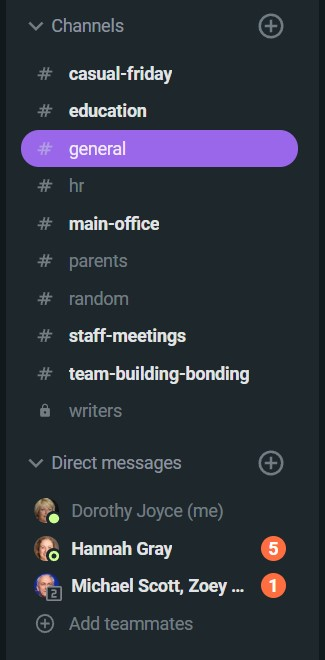
What I find particularly helpful in building trust with my teammates are the ad-hoc video meetings we engage in when we need help with our daily tasks — it’s quick, we get to peek at each other’s home offices, and we even throw in some casual small talk. It’s a win-win situation if you ask me!
Nurturing trust is a long-term and never-ending process but the constant effort boosts employees’ sense of belonging and increases trust among them, even outside the professional setting.
Tip #5: Foster transparent and constant communication
Regular and transparent communication indeed is the basis of all successful virtual teams.
What’s more, the most recent workplace statistics revealed that about 85% of employees said they were most motivated when they get regular updates about company news and information.
According to Melissa Kelly, CEO at Virtual Team Building, a company specializing in team-building activities for remote teams, transparency is crucial for nurturing trust in all teams and overcoming obstacles together:

“Another way to build trust with virtual teams is to increase your transparency. Especially if you are a small or medium-sized business, just tell people what is happening, and why.
You can be transparent about salaries, company revenue, not having a plan (yet) for dealing with a crisis, and similar. If you are real with your people then they will trust you, and you can work through challenges together.”
You should always have in mind that trusting people at a distance is hard because it requires you to be vulnerable. This is why honesty at work paves the way to everything else — don’t hesitate to practice it.
Tip #6: Encourage the use of proper collaboration tools
For remote and hybrid teams to work together and ultimately build trust, communication is key. And regular and constant communication isn’t possible only via email — virtual teams have to rely on various collaboration tools to achieve that.
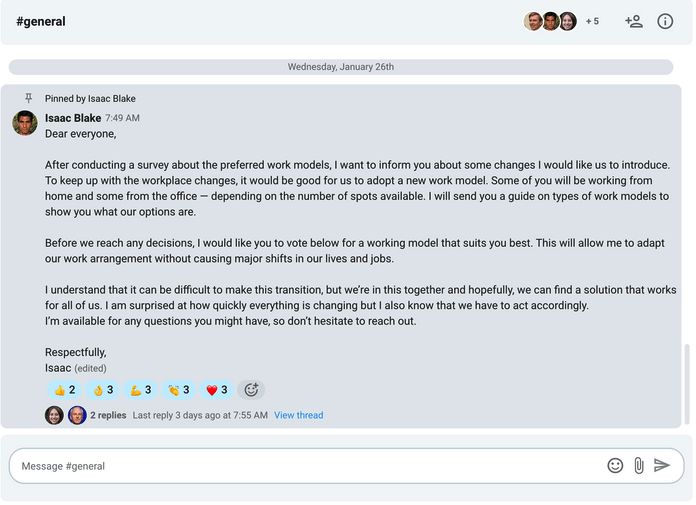
I’ll list some tools to help you start:
- Business messaging apps: With instant messaging apps, the use of email is minimized and real-time communication is much easier.
- Video conferencing tools: Once you find a video conferencing tool that satisfies the needs of your team, you can use it to organize daily, weekly, and monthly meetings.
- Document sharing platforms: Ensuring that company documents are protected and safely stored you should find a reliable document sharing service.
- Project management tools: To keep track of all the tasks and projects your team is working on and provide designated time frames you can rely on a good project management tool.
- Time tracking software: In remote and distributed teams, productivity levels are higher with proper time tracking software that helps keep a record of the employees’ use of time.
- Graphic editors: Many remote teams create visuals and work on graphic projects — thanks to online graphic editors, geographical barriers aren’t a problem anymore.
- Virtual presentation software: If you want to create the illusion of a conference room and give your team a chance to share their work as if they were in the same room, think of investing in reliable virtual presentation software.
If they don’t have to worry about how to do their jobs and stay connected, your people will have more time to know each other better and form meaningful, trusting relationships.
💡 Pumble Pro Tip
For some virtual teams, remote-work apps like Pumble have proven essential for effective communication and seamless collaboration. If you want to learn more about it, check out Pumble’s offer here:
Tip #7: Embrace overcommunication
When working with remote and hybrid teams, overcommunicating isn’t really a bad thing. It helps build a better company culture and nurture trusting relationships.
What you should be careful about is the difference between information overload and overcommunication:
- Information overload usually happens when we receive more information than we can process, often resulting in poor decision-making and decreased performance.
- Overcommunication refers to the constant communication among team members, often aimed at achieving clarity, providing purpose, and establishing accountability.
Embracing overcommunication in virtual teams can help form stronger relationships and cultivate trust because it allows you to deliver important information regularly, stay concise, and send messages to the right people at the right moment.
Tip #8: Manage conflicts accordingly
Workplace conflict is a common occurrence, and even more so among team members working remotely.
What usually causes conflict in virtual teams?
- Withholding information
- Lack of understanding
- Cultural differences and generational gaps
- Burnout and work-related stress
- Lack of teamwork
- Inappropriate workplace behavior
- Limited context
Avoiding conflict altogether isn’t what I’m suggesting you do — that’s the worst you can do. Instead, focus on steering conflict in a way that fosters trust and helps your employees grow.
How?
Well, teach your team members to respectfully disagree with one another, listen actively, and think critically. When they learn to do this, they’ll be able to come up with better solutions and reach better decisions together.
As a strong leader, it’s your job to navigate workplace conflict properly and give your remote employees a foundation to build their trusting relationships. You can do this by:
- Acting early when you notice signs of an impending conflict.
- Accounting for both sides, listening to all versions of the story, and staying objective.
- Handling conflict in a private and safe environment.
Tip #9: Support building interpersonal relationships
I’m aware of how hard it can be to establish meaningful relationships with people you barely see or know. You’re always questioning things, reading between the lines, and trying to fit other people’s words into context.
Even in a professional setting, it all boils down to that essential moment of vulnerability that makes or breaks any relationship.
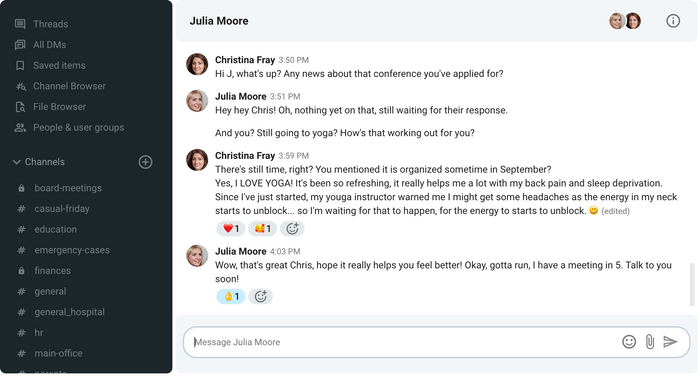
To point out how important interpersonal relationships are for building trust in virtual teams, let me share some personal experiences.
I am extremely invested in taking care of my relationships at work, especially with the people I work closely with.
When I show my dedication to the person, listen, and engage in more than mere workplace communication, the other person can feel it and reciprocate.
I allow myself to be vulnerable in front of others to show them they can do the same with me. So far, my intuition hasn’t deceived me — the people I’ve chosen to open up to have all done the same.
My heart is full when my colleagues tell me I’ve inspired them to do something that makes them feel better and nurtures their mental health. These moments of connecting represent tiny steps that bring us closer to trustworthiness and meaning in our relationships.
Building interpersonal relationships is like forming new synapses in the brain. The more connections the brain makes, the stronger it becomes, right?
I hope this brain analogy resonates with you.
💡 Pumble Pro Tip
If you’re eager to improve your workplace relationships, you might find our text on interpersonal communication helpful:
Tip #10: Promote accountability
In virtual teams, managers and team leads have little oversight of what their remote employees are doing and how. Managers and team leads have to take a leap of faith and believe everyone will do their job on time.
Even though most remote employees struggle with workplace visibility, instilling a sense of belonging can help promote accountability and build trust among them.
Teaching your remote team to be accountable is the road to increased productivity, stronger workplace relationships, and ultimately better outcomes.
You must be wondering how to promote work from home accountability and not micromanage your team. Let me share a few ideas:
- Clearly define team roles.
- Come up with a proper policy and make sure that all employees have the same opportunities and responsibilities.
- Communicate regularly with each team member to learn if they need help.
- Organize weekly video meetings to check in on your team’s progress, ask task-related questions, and help them come up with adequate solutions.
- Manage mistakes carefully and on time.
The point here isn’t to hunt your team down until they reach perfection, it’s rather about making them feel comfortable and safe in the work environment you’ve created for them.
If you provide equal support to all, your team will find it easier to open up to their colleagues and form relationships.
Tip #11: Invest in employee well-being
According to the 2021 Global Workplace Burnout Study, burnout is a major workplace problem that has increased 5% globally over the past year.
It’s paramount to address issues like burnout and support employee well-being in virtual teams if your idea is to create a strong and trusting team.
Virtual teams are harder to handle because team leads and managers have little or no insight into their employees’ lives once the camera is off.
What you have to account for is that each employee is different. So what works for one might not work for another. This is why I would advise steering clear from generic practices and focusing on promoting a better remote experience instead.
I suggest you try the following:
- Define a budget you will devote to activities that support employee well-being.
- Ask your employees what they need to improve their well-being.
- Identify common workplace stressors and work on eliminating them.
- Devote time to short and fun virtual activities during the week to mimic in-person meetings and create situations for connecting outside work.
- Get personal with your team and learn more about their daily lives.
- Create a safe virtual space for sharing personal experiences and ideas.
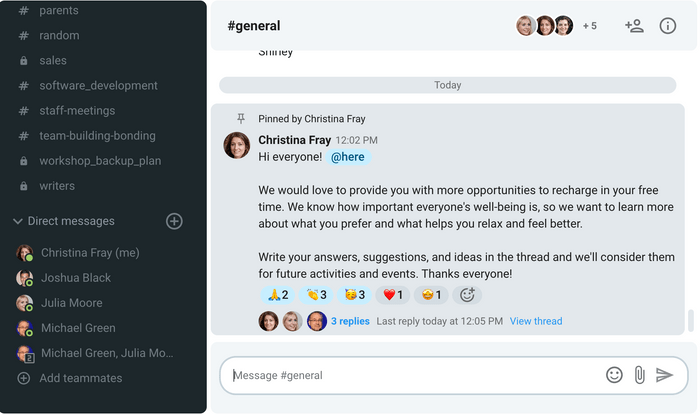
When people don’t feel well in life, they don’t feel well at work. They then tend to isolate themselves and avoid making contact with others, including their teammates.
This becomes an obstacle to building trust among your people, making you work twice as hard to achieve the bare minimum. So, when you invest in your employees’ well-being, you’re investing in higher productivity, better engagement, and stronger relationships — the pillars of thriving organizations.
Tip #12: Promote healthy work-life boundaries
Recent research has shown that remote employees have been working longer and spending time in more meetings.
Now, despite flexible working hours, some remote employees still have a hard time creating proper work-life boundaries and protecting their mental health.
Since the remote workforce has almost doubled since March 2020 and remote work is here to stay, knowing how to set work-life boundaries is essential.
Here are a few ideas to help you support your employees in setting boundaries:
- Encourage employees to take timely lunch breaks.
- Support the use of time tracking software to help employees limit their working hours and avoid burnout.
- Secure weekend time-offs and vacations.
- Restrict workplace communication to business hours only.
- Encourage employees to notify their colleagues about their activity by setting their status or creating an out-of-office email reply.
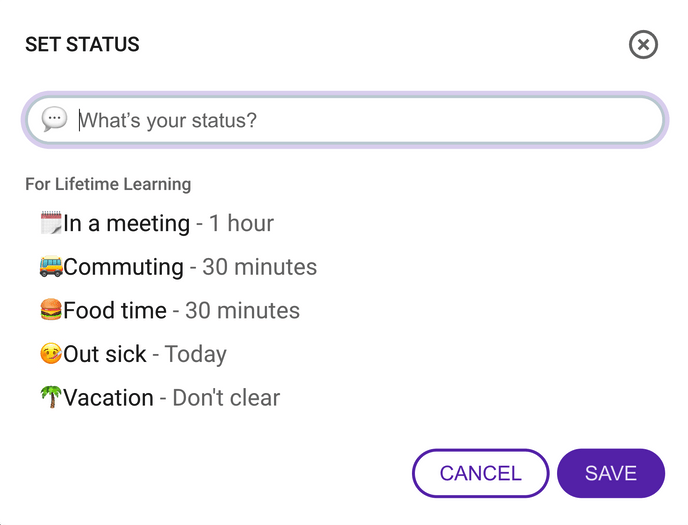
If your people come happy and relaxed to work, they’ll be able to connect better with their teammates and contribute more to the team’s productivity and success.
Teach them to prioritize and value their time because in that way you prioritize the health and success of the entire organization in the long run.
Tip #13: Create a collaborative work environment
For high-trusting teams to work, employees have to communicate and collaborate effectively. And to do that, they need a special environment — a highly collaborative one.
To learn more about the importance of a collaborative work environment, we reached out to Nate Martin, Co-Founder, and CEO at Puzzle Break, a company that organizes virtual escape room activities. He thinks that the best way to do this is to focus on connecting with your people.
He says:

“Connect! Connect and connect and connect some more.
Our entire business model shifted overnight to meeting this basic human need: bringing remote folks closer together. And we’re just one piece of the puzzle.
Leaders need to be making sure their teams are talking to each other, having experiences together, and overcoming objectives together. There is no single silver bullet, it’s all about making the effort every day to connect with our teams.”
I completely agree with Martin here, but I also believe that if you invest time in creating and maintaining a collaborative culture at work, you’ll prioritize trust-building and knowledge sharing among your people.
To support my argument, let me quote Simon Sinek, a British-American author, and inspirational speaker:
“A team is not a group of people who work together. A team is a group of people who trust each other.”
Tip #14: Devote time to virtual team bonding and team building activities
For distributed and remote teams, team bonding and team-building activities play an essential role in fostering trust-filled relationships.
Courtright believes that remote employees should have opportunities to socialize outside their professional setting, too. She argues:

“One of the keys to building trust among team members is to give them opportunities to be social in a setting where work is not the main topic of conversation.”
She goes a step further and gives specific ideas that can help in fostering trust among employees:

“From video coffee one-on-ones to weekly team trivia competitions held at lunchtime, to the now tried-and-true virtual mixology class and happy hour, these are just a few ideas of virtual social events to put in place for your team.
The more social time your team members are able to regularly spend together — even if it’s virtual — the tighter personal bonds they will build with one another, and this will lead to growing trust in your teams.”
Tip #15: Create more opportunities for in-person bonding
According to Bill Catlette, Founder and Partner at Contented Cow Partners, managers should, and must, do their best to nurture trust in virtual teams. He believes this could be achieved by getting together from time to time, in addition to virtual trust-building activities.
He explains in great detail:

“Trust is such an important element that managers must do whatever it takes to engender it within the unit. If the team’s mission is long-term (over the horizon) it will be worth it to spare no expense to periodically get teammates together (belly-to-belly) to bond.
A slightly stepped down effort might put teammates in the same room (okay, Zoom box) to share a meal that has been provided for them, in hopes that the process of breaking bread together will pay dividends via enhanced trust.”
Although rare, in-person meetings represent unique chances to make your remote team even closer.
For example, some of my team members and I met a few months back for the first time.
It was awkward and reserved in the beginning, seeing each other for the first time and getting our impressions in order.
But once we got past that initial part where we had to step outside our comfort zones, we focused on the bonding part and having fun. We had a blast! And I’m confident that we can’t wait to meet again.
Tip #16: Celebrate individual success and achievements
When you’re handling a virtual team, you have to devote time to share individual achievements and teach your team members to be happy about their colleagues’ success.
It’s always wise to recognize your employees for their contribution and effort, but it can be much wiser to normalize celebrating each other’s success. After all, people from the same team spend a lot of time communicating which helps them strengthen their relationships and feel more comfortable with each other.
Managers and team leads can support this relationship-building process by:
- Using daily and weekly meetings to talk about individual achievements.
- Encouraging employees to talk about their non-work-related achievements and desires.
- Asking employees to share something important with the team to help them get out of their comfort zone.
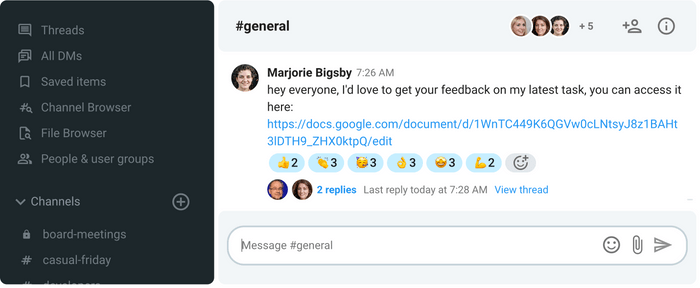
Nothing good can come out of toxicity and negativity in any team — they are silent destroyers of trust. Besides, people more easily engage with others when they feel supported and acknowledged for who they are and what they choose to achieve in life.
Tip #17: Cultivate constructive feedback practices
If you’re aware of the importance of trust, you’ll also know that constructive feedback is also essential.
Discussing problems and mistakes only during annual or quarterly performance reviews can prove detrimental to trust among your people. What you should focus on instead is to nurture this positive attitude towards feedback and teach employees how to use it to their advantage.
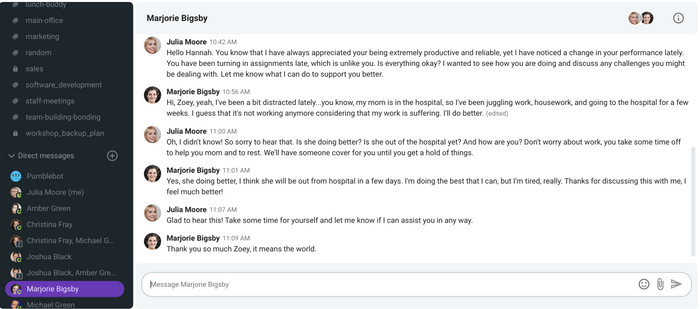
Supporting and promoting regular feedback in your team can help teammates see their mistakes objectively, find better ways to overcome them, and allow teammates to trust you and their peers are working in their best interest.
Some practices to consider:
- Create a short guide that outlines the most important points to consider about feedback.
- Role model constructive feedback during daily and weekly meetings.
- Make sure to give enough one-on-one feedback.
- Encourage employees to speak up if they have problems with their colleagues.
- Organize a feedback mock-up session to practice giving constructive feedback in a virtual setting.
Think of each feedback session as an opportunity to work on trust in your virtual team. If you all get into the habit of providing mindful and timely feedback, the chances are that you will build trust on the go and form stronger workplace bonds.
💡 Pumble Pro Tip
Our extensive guide, 28 Internal communication message templates and worksheets, is packed full of useful internal communication templates, including two feedback templates. You can check out the text and download the feedback templates here:
⏬ Download: Feedback Request Worksheet with Examples
⏬ Download: Feedback Response Worksheet with Examples
Tip #18: Role model honesty and loyalty
Everything starts with you, the operator, the role model, the leader.
How open to trust and vulnerability at work your employees are will greatly depend on how much you exhibit these traits with them. They need someone to teach them the basics of workplace trust and loyalty, and who is better than you?
In most cases, it’s the little gestures that reveal someone’s true intentions and embody trust. So focus on doing these little things every day. You can:
- Show genuine interest in your people’s lives by asking questions and engaging in informal conversations.
- Give everyone a chance to share ideas and initiatives.
- Allow your employees to have a say in important decisions about company operations.
- Proactively seek their feedback to improve work conditions.
- Create opportunities for employees to showcase their skills and share their knowledge — virtual presentations and workshops are a good starting point.
If you expect trust in the workplace, you have to lead the way.
Why is it important to build trust in virtual teams?
People who work in remote, hybrid, and distributed settings rely a lot on trusting each other:
- Employers trust employees will commit to completing their tasks every day.
- Employees trust their employers will provide them with proper equipment, training, and pay.
- Team leads trust their team members will appear for daily and weekly meetings.
- Employees trust their leaders work in their best interest even though they (perhaps) have never met in person.
- Managers trust employees are honest when tracking their hours.
As you can see, trust is a two-way street and requires active involvement from all sides.
Let’s see why trust is so important for the success of virtual teams.
🤝 Trust is the heart of every organization
In one of his research investigating workplace trust, the founding director of the Center for Neuroeconomics Studies and CEO of Immersion Neuroscience, Paul J. Zak, found that employees at high-trust companies:
- Are 74% less stressed,
- Are 106% more energetic at work,
- Are 50% more productive,
- Use 13% fewer sick days,
- Are 76% more engaged,
- Are 29% more satisfied with their lives, and
- Are 40% less likely to experience burnout.
Unlike low-trusting organizations in which the turnover is high and the focus isn’t on the employees, high-trusting companies know that nurturing trust is what makes them stand out from the crowd.
If you want your virtual team to be successful, you have to understand that trust is at the very core of your organization. Once you do that, you should prioritize it and actively work on maintaining it.
When asked about trust in virtual teams, David Ciccarelli, the CEO at Voices, confirmed it should be every organization’s top priority:

“Trust underpins every interaction and permeates all forms of communication. It’s at the heart of every organization.
How do we express the importance of trust, especially with new hires virtually? We’ve enhanced our onboarding training to make sure our new colleagues understand Voices values (of which trust is one of the values) and culture.”
🤝 Trust creates a supportive and productive work environment
Trust makes it easier to collaborate and communicate even when team members aren’t together all the time.
According to Sammy Courtright, the Co-founder and Chief Brand Officer of Ten Spot, an employee engagement and productivity platform, trust is essential for all teams to be successful.
Yet, she emphasizes that “it may feel more urgent for teams to establish trust with one another, especially if they have not been able to meet in person.”
Trust remains the crucial factor to a thriving, supportive, and positive work environment. Courtright explains further:

“Trust does take time to build but once it’s fostered, it enables teams to relax and be themselves with the comfort and security that they can rely on their colleagues — they will not let them down and they will pull their own weight.
This is when creativity can truly flourish. Teams that trust one another are more productive and engaged at work, even when they are not in the same location.”
🤝 Trust allows team members to take risks
Let’s recall Feltman’s definition of trust — it highlights the importance of vulnerability, a key characteristic of high-trusting teams. When people feel they can be vulnerable with their teammates, they also find it easier to engage in riskier situations and take chances.
The key here is that employees are sure their teammates have their back no matter what and especially in urgent situations. When you achieve this, you can be sure that your people will go above and beyond at work and do their best to support their team.
Conclusion: It takes courage to trust and to be trusted
Let’s recall for a moment my bold comparison between virtual teams and long-distance relationships. I hope I proved my point and provided enough arguments to support my claim.
Don’t let the physical distance trick you into believing that trust doesn’t matter in remote and distributed teams.
In fact, it’s one of the most powerful ingredients of thriving virtual teams and long-lived relationships, both personal and professional ones.
So I hope that you’ll find the courage to be vulnerable enough to evoke trust in your people.
I also hope that your people will find the courage to be vulnerable enough to evoke trust in you.
And for those who are still struggling with building trust in their virtual teams, the tips we’ve compiled here will be a solid starting point. Use them to your advantage.




